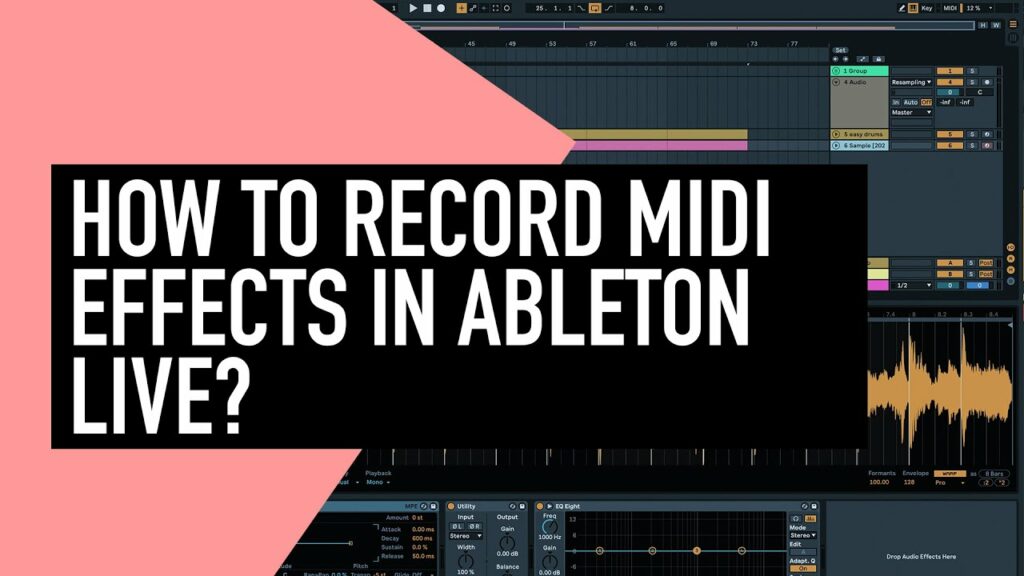The Ultimate Guide to MIDI Recording in Ableton Live: Unleashing Your Musical Potential

Ableton Live’s MIDI recording capabilities empower musicians, producers, and composers to capture their musical ideas with precision and flexibility. Whether you’re creating complex melodies, intricate chord progressions, or dynamic drum patterns, mastering MIDI recording in Ableton Live opens up a world of creative possibilities. In this extensive guide, we’ll explore every aspect of MIDI recording in Ableton Live, from setting up your MIDI controllers to capturing expressive performances and editing MIDI data with precision.
Understanding MIDI Recording:
Before we dive into the specifics of MIDI recording in Ableton Live, let’s establish a foundational understanding of MIDI (Musical Instrument Digital Interface) and its role in music production:
- What is MIDI? MIDI is a universal protocol that allows electronic musical instruments, computers, and other devices to communicate and synchronize with each other. MIDI data consists of messages that convey information such as note pitch, velocity, duration, and expression.
- MIDI in Ableton Live: In Ableton Live, MIDI is used to trigger virtual instruments, control parameters, and record musical performances. MIDI data can be recorded and edited in real-time, allowing for precise control over every aspect of a musical performance.
- Advantages of MIDI: MIDI offers several advantages over traditional audio recording, including the ability to edit note timing, pitch, and velocity after recording. MIDI also allows for seamless integration with virtual instruments, enabling musicians to access a vast array of sounds and textures.
Getting Started with MIDI Recording:
Now that we have a solid understanding of MIDI, let’s explore how to get started with MIDI recording in Ableton Live:
- Setting Up MIDI Controllers:
- Connect your MIDI controller to your computer via USB or MIDI cables.
- Open Ableton Live and navigate to the Preferences menu.
- In the MIDI tab, ensure that your MIDI controller is detected and configured correctly. You may need to select your controller from the list of available input and output devices.
- Creating MIDI Tracks:
- In Ableton Live’s Session or Arrangement View, create a new MIDI track by clicking the “+” button in the track header.
- Select the desired instrument or virtual instrument from the Browser and drag it onto the MIDI track. This will create a new MIDI clip on the track.
- Recording MIDI Clips:
- To record MIDI into a clip, ensure that the MIDI track is armed for recording by clicking the record button in the track header.
- Click the record button in the transport bar, or press the record shortcut key (default: “Shift + Space”), to start recording MIDI input from your controller.
- Play your MIDI controller to trigger notes and record your performance into the MIDI clip.
- Editing MIDI Data:
- After recording MIDI data into a clip, double-click on the clip to open it in the Clip View.
- Use Ableton Live’s editing tools to manipulate and refine the MIDI data. You can adjust note timing, pitch, velocity, and expression using the piano roll editor and other editing features.
Advanced Techniques and Workflow Tips:
Now that we’ve covered the basics of MIDI recording in Ableton Live, let’s explore some advanced techniques and workflow tips to enhance your productivity and creativity:
- Quantization and Groove:
- Experiment with quantization settings to align MIDI notes to a grid and tighten up your performances. Adjust the quantization strength and timing parameters to achieve the desired feel and groove.
- Explore Ableton Live’s groove pool and groove templates to add swing, shuffle, and humanization to your MIDI sequences.
- Recording Multiple Takes:
- Take advantage of Ableton Live’s multiple take recording feature to capture multiple versions of a performance. Enable the “Create Takes” option in the Record/Warp/Launch preferences and record multiple passes of your MIDI performance.
- After recording, audition and select the best take from the takes lane in the clip editor.
- Layering and Splitting MIDI:
- Experiment with layering multiple MIDI clips on the same track to create rich, textured sounds. Use MIDI effects such as arpeggiators, chord generators, and sequencers to create complex musical textures.
- Split MIDI clips into separate clips or tracks to isolate different elements of a performance for further editing and processing.
Integrating MIDI Recording into Your Workflow:
As you become more comfortable with MIDI recording in Ableton Live, consider integrating it into your overall music production workflow in the following ways:
- Sketching Musical Ideas:
- Use MIDI recording to quickly capture musical ideas and sketches. Experiment with different sounds, melodies, and rhythms, and refine your ideas over time.
- Creating Dynamic Performances:
- Use MIDI recording to perform expressive and dynamic musical performances. Experiment with velocity, aftertouch, and modulation to add nuance and emotion to your performances.
- Producing Full Tracks:
- Incorporate MIDI recording into your track production process to create full arrangements and compositions. Layer MIDI clips, automate parameters, and experiment with arrangement to create dynamic and engaging tracks.
Conclusion:
MIDI recording in Ableton Live offers a powerful and flexible workflow for capturing, editing, and producing musical performances. By mastering its features, techniques, and workflow, you’ll unlock a world of creative possibilities for musical expression and experimentation.
Whether you’re sketching out ideas, performing dynamic performances, or producing full tracks, MIDI recording in Ableton Live provides the tools and flexibility needed to bring your musical visions to life with precision and flair. So, dive in, experiment, and let the boundless creativity of MIDI recording inspire your musical journey in Ableton Live!







